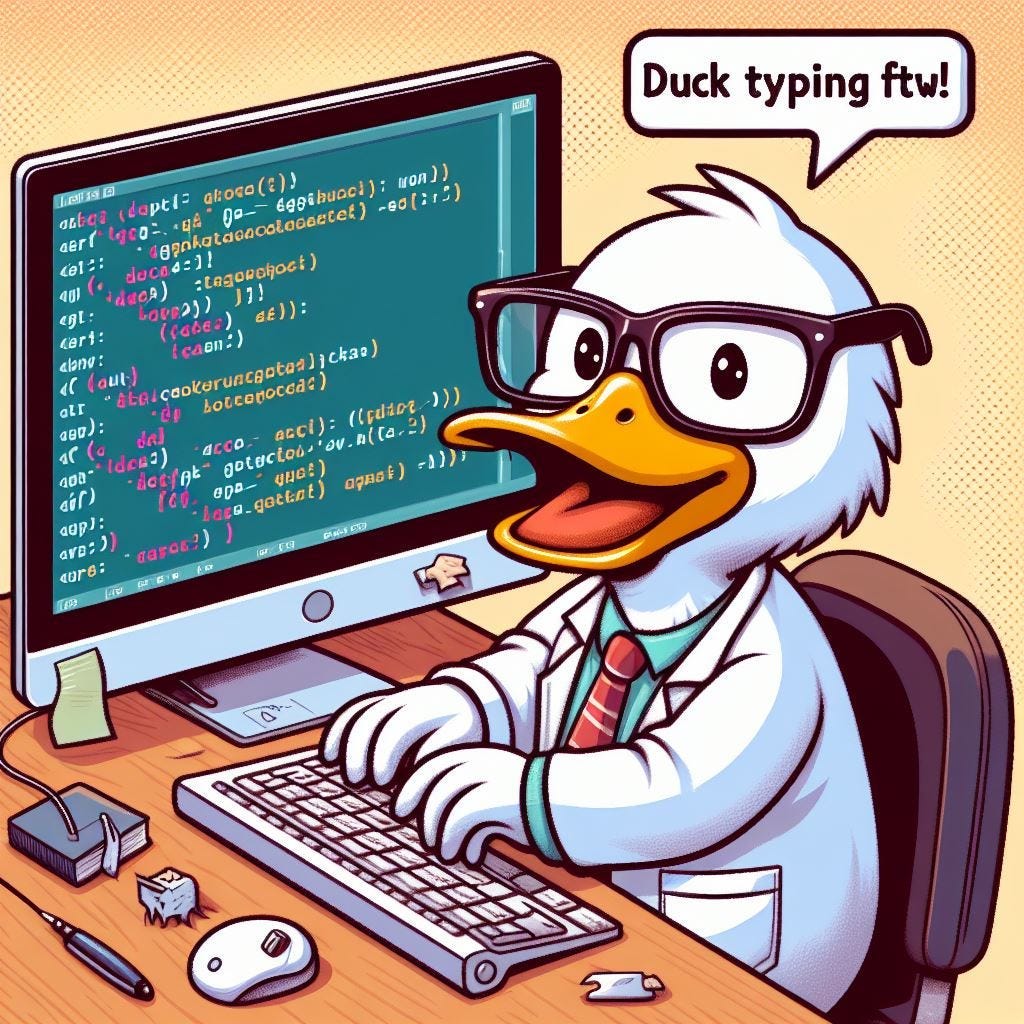🦆 Duck Typing vs Dynamic Typing in Ruby: Simplifying the Concepts! 🚀
🦆 Duck Typing vs Dynamic Typing in Ruby: Simplifying the Concepts! 🚀
Ruby is a dynamic, flexible, and expressive language, making it a favorite among developers. Two fascinating concepts in Ruby — Duck Typing and Dynamic Typing — often create confusion, but don’t worry! This blog will clarify everything with examples and relatable analogies. Let’s dive in! 🌊

🌟 What is Dynamic Typing?
Dynamic Typing means variables do not have a fixed type. Instead, the type is determined at runtime based on the value assigned to the variable. In simpler terms, Ruby doesn’t care about what type of object a variable holds, as long as it can perform the required actions.
🛠 Example of Dynamic Typing:
x = 10 # x is now an Integer
x = "Hello" # x is now a String
x = [1, 2, 3] # x is now an ArrayHere, x changes its type from an Integer to a String and then to an Array. No complaints from Ruby—it's happy as long as the operations are valid! 🎉
🔥 Advantages of Dynamic Typing:
- Flexibility: You can assign any type to a variable without restrictions.
- Conciseness: No need to declare types explicitly.
⚠️ Caution:
Dynamic Typing can lead to runtime errors. For example:
x = "Ruby"
puts x + 10 # Error: TypeError (String can't be coerced into Integer)Ruby assumes x + 10 should work only if x is numeric. Hence, runtime checks are crucial.
🦆 What is Duck Typing?
The term comes from the phrase:
“If it looks like a duck, swims like a duck, and quacks like a duck, then it probably is a duck.”
In Ruby, Duck Typing is about an object’s behavior rather than its class. If an object responds to a method or action, Ruby doesn’t care about its type. If it quacks like a duck, it’s treated like a duck! 🦆
🛠 Example of Duck Typing:
Imagine a scenario where we have different objects with a speak method:
class Dog
def speak
"Woof! 🐶"
end
end
class Cat
def speak
"Meow! 🐱"
end
end
class Duck
def speak
"Quack! 🦆"
end
end
def animal_sound(animal)
puts animal.speak
end
animal_sound(Dog.new) # Output: Woof! 🐶
animal_sound(Cat.new) # Output: Meow! 🐱
animal_sound(Duck.new) # Output: Quack! 🦆Ruby doesn’t care if the object is a Dog, Cat, or Duck. As long as it implements the speak method, it's valid. 💡
🤔 Dynamic Typing vs Duck Typing: Key Differences
🧪 Dynamic Typing
- What it is: Determines the type of a variable at runtime.
- Focus: The data type of the variable.
- Validation: Ensures compatibility between types at runtime.
- Errors: Can lead to TypeErrors when incompatible operations are performed.
🦆 Duck Typing
- What it is: Focuses on an object’s behavior, not its class or type.
- Focus: What methods the object implements (its “behavior”).
- Validation: Relies on whether the object implements the required method.
- Errors: Leads to NoMethodError if the required method is missing.
💡 When to Use Duck Typing?
Duck Typing is useful in polymorphic behavior where multiple objects of different classes share common functionality. Examples include:
- Designing APIs.
- Flexible implementations of iterators, parsers, or renderers.
🔥 Example: A Payment System
class PayPal
def pay(amount)
"Paid #{amount} using PayPal. 💸"
end
end
class CreditCard
def pay(amount)
"Paid #{amount} using Credit Card. 💳"
end
end
def process_payment(payment_method, amount)
puts payment_method.pay(amount)
end
process_payment(PayPal.new, 100) # Output: Paid 100 using PayPal. 💸
process_payment(CreditCard.new, 200) # Output: Paid 200 using Credit Card. 💳As long as the object implements the pay method, it's a valid payment method.
🚩 Pitfalls to Watch For
1. Duck Typing Errors:
If an object doesn’t implement the required method, you get a NoMethodError. Use .respond_to?(:method_name) to check.
if obj.respond_to?(:speak)
obj.speak
else
puts "This object can't speak! ❌"
end2. Dynamic Typing Bugs:
Since types aren’t enforced, runtime errors are common. Writing unit tests is essential in Ruby projects.
🌈 Conclusion
Both Dynamic Typing and Duck Typing are pillars of Ruby’s elegance and flexibility. While Dynamic Typing offers freedom with variables, Duck Typing encourages focusing on object behavior rather than class hierarchies. Mastering these concepts will help you write cleaner and more efficient Ruby code! 🚀
Let me know in the comments if you found this helpful! ✨ Happy coding! 💻
Comments
Post a Comment